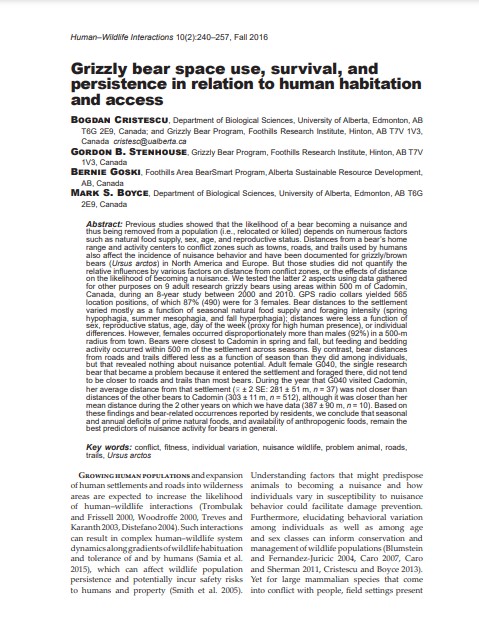Grizzly bear space use, survival, and persistence in relation to human habitation and access.
Bosque Modelo:
Foothills
Temática:
Conservación
Tipo de documento:
Artículo científico
Resumen
Previous studies showed that the likelihood of a bear becoming a nuisance and thus being removed from a population (i.e., relocated or killed) depends on numerous factors such as natural food supply, sex, age, and reproductive status. Distances from a bear’s home range and activity centers to confl ict zones such as towns, roads, and trails used by humans also aff ect the incidence of nuisance behavior and have been documented for grizzly/brown bears (Ursus arctos) in North America and Europe. But those studies did not quantify the relative infl uences by various factors on distance from confl ict zones, or the eff ects of distance on the likelihood of becoming a nuisance. We tested the latter 2 aspects using data gathered for other purposes on 9 adult research grizzly bears using areas within 500 m of Cadomin, Canada, during an 8-year study between 2000 and 2010. GPS radio collars yielded 565 location positions, of which 87% (490) were for 3 females. Bear distances to the settlement varied mostly as a function of seasonal natural food supply and foraging intensity (spring hypophagia, summer mesophagia, and fall hyperphagia); distances were less a function of sex, reproductive status, age, day of the week (proxy for high human presence), or individual diff erences. However, females occurred disproportionately more than males (92%) in a 500-m radius from town. Bears were closest to Cadomin in spring and fall, but feeding and bedding activity occurred within 500 m of the settlement across seasons. By contrast, bear distances from roads and trails diff ered less as a function of season than they did among individuals, but that revealed nothing about nuisance potential. Adult female G040, the single research bear that became a problem because it entered the settlement and foraged there, did not tend to be closer to roads and trails than most bears. During the year that G040 visited Cadomin, her average distance from that settlement ( ± 2 SE: 281 ± 51 m, n = 37) was not closer than distances of the other bears to Cadomin (303 ± 11 m, n = 512), although it was closer than her mean distance during the 2 other years on which we have data (387 ± 90 m, n = 10). Based on these findings and bear-related occurrences reported by residents, we conclude that seasonal and annual defi cits of prime natural foods, and availability of anthropogenic foods, remain the best predictors of nuisance activity for bears in general.
Información Bibliográfica
Autor:
Cristescu, B., Stenhouse, G. B., Goski, B., & Boyce, M. S.
Revista:
Human–Wildlife Interactions
Año:
2016
N°:
2
País :
Canadá
Páginas:
240 - 257
Volumen:
10
Idioma:
Ingles
Palabras claves
confl ict, fi tness, individual variation, nuisance wildlife, problem animal, roads, trails, Ursus arctos





